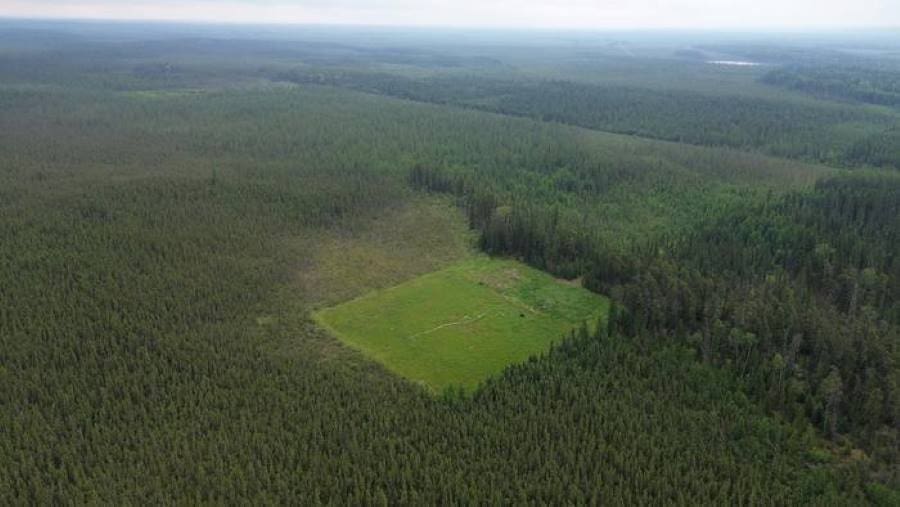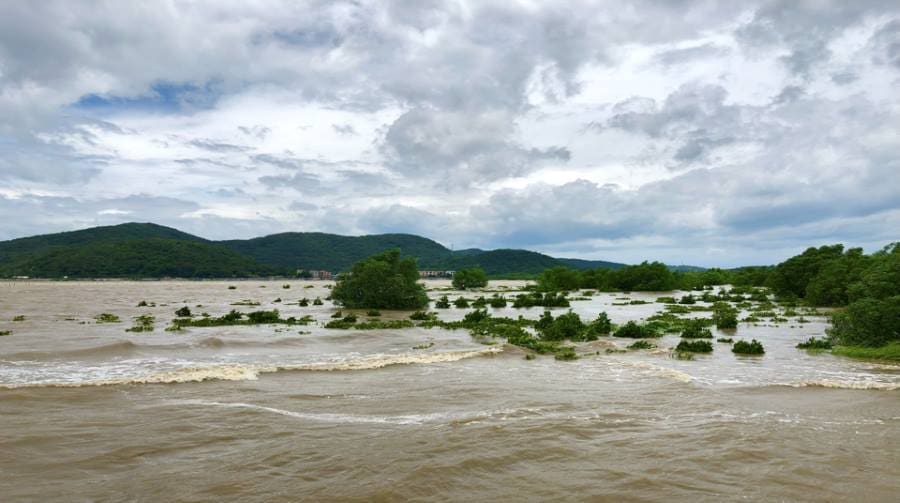Explore the latest insights from top science journals in the Muser Press daily roundup, featuring impactful research on climate change challenges.
In brief:
Restoring oil wells back to nature with moss
In what could represent a milestone in ecological restoration, researchers have implemented a method capable of restoring peatlands at tens of thousands of oil and gas exploration sites in western Canada.
Researchers from the University of Waterloo led the project that involves lowering the surface of these decommissioned sites, known as well pads, and transplanting native moss onto them to effectively recreate peatlands. This is the first time researchers have applied the method to scale on an entire well pad. The study, published in Ecological Engineering, found that the technique results in sufficient water for the growth of peatland moss across large portions of the study site.

Historically, restoration efforts involved planting trees or grasses to establish upland forests or grasslands. This new method returns a well pad to its condition before drilling occurred and supports the ongoing development of peatland restoration techniques. The discovery can help the oil and gas industry and its regulators better mitigate the long-term impact of resource extraction on Canadian peatland ecosystems.
“These results are the first to suggest that the re-establishment of peatland vegetation on full-scale lowered well pads is possible. through peatlands, which can negatively affect the ecosystem in surrounding areas,” said Murdoch McKinnon, PhD candidate in the Faculty of Environment. “Well pads bury all of the native peatland vegetation under clay or sand, negatively impacting the ability of the peatland to sequester carbon and also reducing the availability of habitat for wildlife.”
The researchers plan to continue monitoring ecosystem development on the tested well pads to confirm that the transplanted mosses will be self-sustaining over the coming decades. Partners at the Northern Alberta Institute of Technology’s Centre for Boreal Research are now applying some of the study’s recommendations at sites across northern Alberta.
“Preserving peatlands is critical because of the role they play storing and supplying water in the landscape,” said Dr. Richard Petrone, a professor in the Department of Geography and Environmental Management at Waterloo. “They are also our best choice for nature-based climate change solutions because of the vast amounts of carbon that they store.”
In the future, researchers will focus on increasing the amount of water that flows from surrounding natural peatlands into well pads to further optimize soil moisture. This will be an essential step given the sensitivity of the native mosses to drying out and might therefore improve regrowth.
Journal Reference:
Murdoch E. McKinnon, Felix C. Nwaishi, Bin Xu, Scott J. Ketcheson, Melanie Bird, Richard M. Petrone, ‘Hydrologic assessment of mineral substrate suitability for true moss initiation in a boreal peatland undergoing restoration’, Ecological Engineering 215, 107615 (2025). DOI: 10.1016/j.ecoleng.2025.107615
Article Source:
Press Release/Material by University of Waterloo
In two decades increasing urban vegetation could have saved over 1.1 million lives
Increasing urban vegetation by 30 % could save over one-third of all heat related deaths, saving up to 1.16 million lives globally from 2000 to 2019 according to a 20-year modelling study of the impact of increasing greenness in more than 11,000 urban areas.
The study, led by Monash University Professor Yuming Guo and published in The Lancet Planetary Health, showed that increasing vegetation levels by 10%, 20%, and 30% would:

- decrease the global population-weighted warm-season mean temperature by 0.08 °C, 0.14 °C, and 0.19 °C, respectively.
- could prevent 0.86, 1.02, and 1.16 million deaths, respectively, representing 27.16 %, 32.22 %, and 36.66 % of all heat-related deaths from 2000 to 2019.
The impact on lives of increasing urban vegetation is impacted by different climate types, greenness levels, socioeconomic statuses, and demographic characteristics
Urban areas in Southern Asia, Eastern Europe, and Eastern Asia have the greatest reduction in heat-related deaths.
The study aimed to detect the potential reduction in global heat-related deaths by increasing greenness in the warm season from 2000 to 2019 in 11,534 urban areas. Heat-mortality associations were assessed by using data from 830 locations in 53 countries and extrapolated to each urban centre.
While increasing greenness has been proposed as a heat-related death mitigation strategy, according to Professor Guo, “this is the first modelling study to estimate both the cooling and modifying effects of greenness, providing a more comprehensive assessment of its benefits in mitigating heat-related mortality,” he said.
“These findings indicate that preserving and expanding greenness might be potential strategies to lower temperature and mitigate the health impacts of heat exposure.”
Heat exposure is a major public health threat and is increasing due to climate change. Between 2000–2019, heat exposure was associated with 0.5 million deaths per year, accounting for 0.91 % of global mortality. According to Professor Guo, estimates of heat-related deaths are projected to range from 2.5 % in North Europe to 16.7 % in South-East Asia during 2090-99, “under the most extreme global warming scenarios.”
Studies show that greenness has a cooling effect on temperature, via shading surfaces, deflecting radiation from the sun, and evapotranspiration (evaporation from both the ground and plants) which promotes air convection. This, in turn, cools the ambient temperature leading to a decrease in population heat exposure, thereby reducing the heat-related mortality burden.
According to Professor Guo there is emerging evidence has also shown that greenness could modify the heat-related mortality risk, potentially related to factors such as mental health, social engagement, physical activity, and air pollution.
The researchers used data from the Multi-Country Multi-City (MCC) Collaborative Research Network which was developed in 2014 to look at population-wide associations between environmental stressors, climate, and health across countries and regions. In this study, daily mortality and weather variables were extracted from 830 locations in 53 countries .
Greenness was measured via the Enhanced Vegetation Index (EVI), a satellite-based vegetation index derived from images collected by the National Aeronautics and Space Administration’s Terra satellite. An “urban area” was defined as an area with a density of at least 1,500 inhabitants per km2 of permanent land and a total population of over 50,000.
If the level of vegetation is increased by 30 % the average number of lives saved from 2000 to 2019 by region is:
- Europe – 396,955
- North America – 69,306
- Latin American and the Caribbean – 123,085
- Africa – 35,853
- Asia – 527,989
- Oceania – 2,733
- Australia and New Zealand – 2,759
Journal Reference:
Wu, Yao et al., ‘Estimating the urban heat-related mortality burden due to greenness: a global modelling study’, The Lancet Planetary Health (2025). DOI: 10.1016/S2542-5196(25)00062-2. Also available on ScienceDirect.
Article Source:
Press Release/Material by Monash University
International experts lead calls to embed nature in city infrastructure for better health and climate resilience
Trees, parks, wetlands and green roofs can no longer be seen as a ‘nice-to-have’ aesthetic enhancement but a vital component for creating climate-resilient, healthier and more equitable cities, according to an international paper led by the University of Surrey’s Global Centre for Clean Air Research (GCARE).
The research – which involved experts representing 11 countries as part of the UKRI-funded RECLAIM Network Plus – found that urban greening has a range of benefits, including cooler streets, cleaner air and water, improved mental health and greater biodiversity.
Global case studies highlighted in the paper demonstrate how different cities are making nature-based solutions work in practice. Singapore’s ‘City in Nature’ has seen major success with its green corridors and vertical gardens that help reduce heat and support biodiversity. In Cardiff, more than 80,000 trees have been planted as part of the city’s One Planet Strategy, while Copenhagen has integrated green roofs and climate-resilient neighbourhoods to manage flood risk and improve liveability.
The research, published in Frontiers’ Sustainable Cities, also stresses the importance of meaningful community involvement and equitable access to green spaces to avoid ‘green gentrification’ – where improvements risk pricing out the very communities they aim to support.
Professor Prashant Kumar, Founding Director of GCARE and lead author of the paper, said:
“Urban greening can be a cost-effective and practical solution to some of our most pressing challenges – from climate change and biodiversity loss to growing health inequalities. Cities like Singapore have shown what’s possible, but our research highlights critical barriers here in the UK that requires collaboration and inclusive design to make this a reality.

“Nature-based infrastructure is not just a ‘nice-to-have’ aesthetic enhancement but a fundamental component of sustainable urban development. I’m proud to lead the RECLAIM Network Plus, a vibrant community of researchers, businesses, charities, environmental groups, and policymakers driving impactful research and leadership in urban greening.”
To help cities deliver urban greening at scale, experts are calling for integrated action that embeds nature into every stage of planning and policy. This includes incentivising developers to prioritise nature-based infrastructure and securing long-term funding.
With contributed insights across academia, government and industry, RECLAIM Network Plus sets in place new resources and guidance – from minimum green space targets to stronger funding and coordination across health, housing and climate policy.
Ben McCallan, Greener Futures Engagement Lead at Surrey County Council and co-author of the study, said:
“Unfortunately, Surrey has the most polluted stretch of highway in the country, which is why we’ve included urban greening as a priority in our Local Nature Recovery Strategy. The RECLAIM Conference is always a fascinating look into how other areas are approaching green infrastructure – and highlights the many benefits it can bring to people and nature. It also shines a light on how far we need to go in order to match the efforts of other countries tackling climate change and nature loss.”
Tools like AI, Geographic Information Systems (GIS) and remote sensing are increasingly enabling cities to map environmental risks, inform smarter design and monitor the long-term impact of green infrastructure. Combined with data-driven decision making, these technological advancements can help accelerate progress towards multiple Sustainable Development Goals and support the large-scale delivery of urban greening.
Professor Veronica Soebarto, Lead Initiative in Green Urban Futures at the University of Adelaide’s Environment Institute and co-author of the paper, said:
“Considering the many benefits of greening, there is no acceptable justification to not incorporate it within city planning, designs and developments. With warming climates occurring around the world, urban greening is essential in providing reliefs from extreme heat by cooling the outdoor environment and reducing heat that enters buildings. At the same time, it is a solution that brings nature to cities, positively impacting health and wellbeing, and improving liveability.”
The paper was developed through the RECLAIM Network Plus (Reclaiming Forgotten Cities – Turning Cities from Vulnerable Spaces to Healthy Places for People), funded by UK Research and Innovation (UKRI). It is led by the University of Surrey’s GCARE in collaboration with the UK Centre for Ecology & Hydrology (UKCEH) and the Universities of Bath, Bangor and Warwick.
Journal Reference:
Kumar P, Sahani J, Corada Perez K, Ahlawat A, Andrade MdF, Athanassiadou M, Cao S-J, Collins L, Dey S, Di Sabatino S, Halios CH, Harris F, Horton C, Inostroza L, Jones L, Rodding Kjeldsen T, McCallan B, McNabola A, Kumar Mishra R, Kumar Mishra S, Sperandio Nascimento EG, Owen G, Ravindra K, Reis NC, Soebarto V, Wenk J, Wood HS and Yao R, ‘Urban greening for climate resilient and sustainable cities: grand challenges and opportunities’, Frontiers in Sustainable Cities 7: 1595280 (2025). DOI: 10.3389/frsc.2025.1595280
Article Source:
Press Release/Material by University of Surrey
New method precisely calculates how mangroves protect coasts against strong waves
Imagine a natural fortress standing strong against raging storms. That’s what mangroves and other forested wetlands do for our coastlines. But how well do they protect us, and against which storms? Researchers from Sun Yat-Sen University, China, and the Royal Netherlands Institute for Sea Research (NIOZ) have uncovered a new and easy method to predict the effectiveness of these natural barriers during extreme weather events. This is an important new insight and tool for coastal managers and policymakers.
The study was published in journal Proceedings of the National Academy of Sciences (PNAS).
We have long known that mangroves and other forested wetlands can act as natural shields against floods. But when it comes to extreme storms, we haven’t had a clear picture of just how well they work. The available models for predicting how much these forests can reduce wave heights are often too complicated for many coastal managers to use. Plus, figuring out the right numbers to plug into these models — especially in extreme conditions — is a tough nut to crack.

New way to measure protection
To tackle this, a team of international researchers gathered data from some of the biggest waves ever recorded in forested wetlands. They looked at waves during a typhoon in China, as well as data from labs and other field studies around the world. What they found is remarkable: mangrove forests of about 100 m width can half the storm wave height. That’s a significant lowering of the waves, giving quite some protection to the coastline behind the mangrove forest.
But that’s not all. The team tested 20 different ways to calculate the drag that trees create against water wavy motions. Most of these methods couldn’t predict wave attenuation in storm events. So, they came up with a new, easy-to-use method they called the HU method.
“This method doesn’t need complicated numbers or detailed tree measurements,” says lead researcher Zhan Hu. “It’s simple enough that coastal practitioners or volunteers with a few existing measurements can use it to figure out how well their local forested wetlands can protect against waves.”
Saving coasts as well as money
“This study is a big deal for coastal protection” says Tjeerd Bouma, researcher at the Royal Netherlands Institute for Sea Research (NIOZ) who also worked on the project. “The HU method gives coastal managers and scientists a practical tool to assess how well their local forests can reduce wave heights during storms. This can help in designing natural coastal defenses, potentially saving billions of dollars worldwide.
“Plus, the study reminds us how important it is to protect and restore mangroves and other forested wetlands like willows,” Bouma adds. “They’re not just wave-blockers; they also capture carbon, provide habitats for wildlife, and clean our water.”
Wave non-linearity
“No, the method is not named after me,” laughs Prof. Zhan Hu. “The name rather reflects the approach that is based on the relation between wave height ‘H’ and Ursell number U, which is an index for wave nonlinearity.” In a nutshell, this method works as the wave attenuation is closely linked to the nonlinear wave effect, which is depicted by the HU relations. And the same HU relation can be applied for both calm and storm weather conditions. The novel methods use the same HU relation in calm weather (but highly nonlinear) to predict the wave height attenuation during storm events, and bypassing the need of quantifying drag.
Other wetlands and coastal areas
While the HU method is a great start, the researchers know it’s not perfect. It works best for specific types of rigid, above-ground forests. Future work will focus on making the HU method work for different kinds of wetlands and coastal areas. They also want to explore what happens when trees start to sway in the wind and how much wave reduction is possible.
“In short, this research is a huge step forward in understanding how nature can protect our coasts,” concludes Hu. “The HU method offers a new way to predict wave reduction during extreme storms, opening the door to more sustainable coastal management.”
Journal Reference:
Z. Hu, S. Temmerman, Q. Zhu, X. Wang, J. Wu, T. Xu, K. Schoutens, T. Suzuki, Z. Yang & T.J. Bouma, ‘Predicting nature-based coastal protection by mangroves under extreme waves’, Proceedings of the National Academy of Sciences 122 (12) e2410883122 (2025). DOI: 10.1073/pnas.2410883122
Article Source:
Press Release/Material by Royal Netherlands Institute for Sea Research (NIOZ)
Featured image credit: Gerd Altmann | Pixabay




